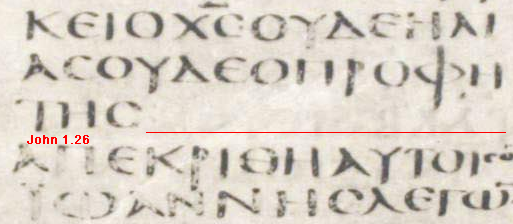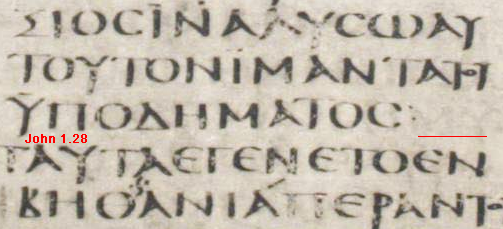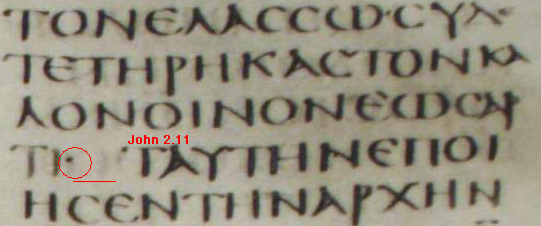
 |
Freethought & Rationalism ArchiveThe archives are read only. |
|
|
#41 | |
|
Banned
Join Date: Dec 2005
Location: Chicago, IL
Posts: 1,289
|
Quote:
Yes or no? JG |
|
|
|
|
|
#42 | |
|
Veteran Member
Join Date: May 2005
Location: Midwest
Posts: 4,787
|
Quote:
 And here are some scans of the first page of John in Sinaiticus, folio 48a, each showing a line that has failed to be filled in all the way to the margin:  (The faint letters in the space at the end of the line are not erasures; they are showing through from the other side of the folio, 48b.)     There are other unfilled lines from the first page of John; these are not all. At any rate, how rare is rare? Here are some more suspended dots that appear in the middle of a line and appear to have space left for them:     These four scans are all from folio 48b. Ben. |
|
|
|
|
|
#43 | |||
|
Banned
Join Date: Jan 2007
Location: Canada
Posts: 528
|
Quote:
One important point (and it should be underlined) is that it is extremely likely that the scribe is here copying the dots from his master-copy, hence the variation in the position of the dots and the length of a less than complete line ending with a dot or a full 'colon'. That is, these marks are not invented by the scribe of Sinaiticus, nor is their meaning. Quote:
The Cambridge Five come to mind as the pentultimate example of what English universities breed. Although the 'Oxford' movement, which subverted a massive number of retarded English protestants back into medieval Catholicism complete with spanking and other extreme penance is a good runner-up for what is best in university settings. Quote:
|
|||
|
|
|
|
#44 | |
|
Banned
Join Date: Dec 2005
Location: Chicago, IL
Posts: 1,289
|
I wrote:
I s there anyone among all of the recognized professional text critics, from Aland to Ehrman, from Elliot to Robinson, from Robinson to Warren, from Wieland to Williams, anyone among those who have worked on the UBS and the NA texts and/or who now work at the Institut für neutestamentliche Textforschung or the Center for the Study of New Testament Manuscripts, who backs you up on these matters? Yes or no? "Nazaroo" replied: Which, in effect means, no, not a single one. He then went on to say: Quote:
How you know this is beyond me. Seems to me that it's right up there in truth value with your claim to know with certainty that "Ehrman's people" dunnd your website, and we all know how much truth value there was in that claim. And even if it were the case that the social status of text critics is what you claim it to be, it's irrelevant to the question of the truth of what they say. And the fact remains that no text critic, no matter what their social standing and background, has ever though or believed or proclaimed that the dots and spaces that you point to has the significance you claim they have. Now it may very well be that you have come accross something no one has ever seen. But it also might be -- and I think that this is more likely the case -- that your claim has no merit whatsoever. Too bad you won't admit this, even as a possibility. A sure sign of a crank. JG |
|
|
|
|
|
#45 |
|
Banned
Join Date: Jan 2007
Location: Canada
Posts: 528
|
Oh I don't know. Lets look then at the significance of the fact that a Roman Catholic Cardinal is the head of the editing commitee for the UBS 'modern' critical edition.
Or better yet, lets look into the Oxford movement in more detail: Secret History of the Oxford Movement <-- Click here for your free copy. |
|
|
|
|
#46 | |
|
Veteran Member
Join Date: Jan 2001
Location: In the dark places of the world
Posts: 8,093
|
Quote:
If these *were* an invention of the scribe of Sinaiticus, then I'd still expect the placement to be less than perferct. Simple human imperfection at work. |
|
|
|
|
|
#47 | |
|
Banned
Join Date: Oct 2002
Location: NYC
Posts: 10,532
|
Quote:
RED DAVE |
|
|
|
|
|
#48 |
|
Banned
Join Date: Jan 2007
Location: Canada
Posts: 528
|
|
|
|
|
|
#49 | |
|
Junior Member
Join Date: Feb 2007
Location: Shores of the utmost west
UK
Posts: 49
|
Quote:
Hmmm. First, it seems a little harsh to damn all Cambridge scholarship for five traitors. True, they are starting to lag behind some American universities in recent years, but Trinity College alone (the one pictured in your link) still has more Nobel Prizes than France (31 to 28 by 2002, IIRC), not to mention the other colleges. In any case, it's not as if selling secrets to the enemy is a purely Cambridge affair: http://www.cnn.com/interactive/us/01...t.exclude.html Second, your implied characterisation of English Universities as full upper class rich twits displays only your ignorance and your prejudice. Sure, there are plenty of well-off public school* types, but many of them are hard-working dedicated students (I know how hard they work because I taught some of them when I was there), and a large proportion of students are from less well-off state-school backgrounds, who are similarly hard-working. If this post of yours is what you consider a reasoned argument then no wonder you attract the strong criticism you do on this forum MT *For traditional reasons, in the UK, public school refers to fee-paying, private schools. Confusing, I know. |
|
|
|
|
|
#50 | |
|
Banned
Join Date: Jan 2007
Location: Canada
Posts: 528
|
Quote:
|
|
|
|
| Thread Tools | Search this Thread |
|